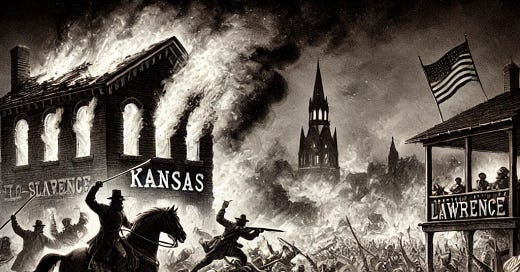Born in Missouri, I was closer to Lawrence, KS, than to Colombia, MO; so growing up I became a fan of the Kansas Jayhawks basketball program. Decades later I learned of this evil and believe there is still a sliver of hate between these arch rivals that may span generations back to this point.
The course of history is rarely shaped by grand proclamations alone. It is hammered into form by fire, by force, and by the brutal collision of irreconcilable principles. And so it was on this day, May 21, 1856, in Lawrence, Kansas, where the fate of the American republic was further sealed—not with a constitutional debate nor a lofty discourse on the moral burden of slavery, but with cannon fire, torched presses, and the ruthless fist of tyranny.
A force of over 800 pro-slavery men, fueled by hatred and emboldened by the doctrine that some men are meant to own others, descended upon the town of Lawrence with the full blessing of the so-called “law.” Under the guise of enforcing legal authority, they came not as officers of justice but as harbingers of destruction, their mission clear: to crush the free-state resistance that stood against the spreading rot of human bondage.
They laid waste to the Free State Hotel, reducing its walls to rubble with artillery. They shattered the printing presses of The Kansas Free State and The Herald of Freedom, silencing the voice of abolition beneath the weight of their tyranny. Private homes were looted, businesses ransacked, and the streets, once hopeful with the dream of liberty, echoed only with the laughter of victors who celebrated their ruinous conquest.
And yet, for all their violence, they did not extinguish the flame of resistance. If anything, they stoked it into an inferno. Lawrence did not fall that day; it was baptized.
Its destruction became a rallying cry, an unassailable proof that compromise with the enslavers was not only futile but suicidal. And while the city’s ashes smoldered, in another part of the territory, a man named John Brown sharpened his resolve. In the wake of this atrocity, he would exact his own brutal vengeance at Pottawatomie Creek, ensuring that blood would answer blood in this war for the soul of America.
The Sacking of Lawrence was not a battle. It was a harbinger. A nation that could not resolve its greatest moral contradiction in the halls of Congress or the courts of law was now careening toward the only other path left to it—war. And as the fires of Lawrence died down, the fires of the Civil War loomed ever nearer.




How very true about Lawrence , Kansas it became the face of Civil War to come . Funny how that saying “ if we don’t learn from our past we are doomed to repeat it !”